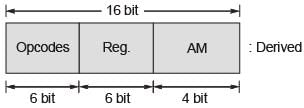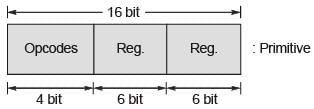GATE Exam > GATE Questions > A processor has 64 registers and uses 16-bit ...
Start Learning for Free
A processor has 64 registers and uses 16-bit instruction format. It has two types of instructions: I-type and R-type. Each I-type instruction contains an opcode, a register name, and a 4-bit immediate value. Each R-type instruction contains an opcode and two register names. If there are 8 distinct I-type opcodes, then the maximum number of distinct R-type opcodes is ________.
Correct answer is '14'. Can you explain this answer?
Verified Answer
A processor has 64 registers and uses 16-bit instruction format. It ha...
Given, 16 bit instruction and 64 registers
I-type:

R-type:

1. Primitive instruction
R-type:

2. Number of operation possible = 24 = 16
3. Number of tree opcodes = (16 – x)
Assume x is number of R-type instruction existed.
4. Number of I-type instruction possible = (16 – x) × 22
8 = 64 – 4 x
4x = 64 – 8 = 56
x = 56/4 ⇒ 14
I-type:

R-type:

1. Primitive instruction
R-type:

2. Number of operation possible = 24 = 16
3. Number of tree opcodes = (16 – x)
Assume x is number of R-type instruction existed.
4. Number of I-type instruction possible = (16 – x) × 22
8 = 64 – 4 x
4x = 64 – 8 = 56
x = 56/4 ⇒ 14
Most Upvoted Answer
A processor has 64 registers and uses 16-bit instruction format. It ha...
To find the maximum number of distinct R-type opcodes, we need to consider the number of bits available for the opcode in the 16-bit instruction format and the constraints given in the problem.
Given information:
- Processor has 64 registers
- Instruction format is 16-bit
- Two types of instructions: I-type and R-type
- Each I-type instruction contains an opcode, a register name, and a 4-bit immediate value
- Each R-type instruction contains an opcode and two register names
- 8 distinct I-type opcodes
Calculating the number of bits available for the opcode:
In a 16-bit instruction format, the opcode can occupy a certain number of bits. To find this number, we subtract the bits occupied by other components of the instruction (register names and immediate value) from the total number of bits in the instruction format.
- Register name: Since there are 64 registers, we need 6 bits to represent each register (2^6 = 64). Therefore, the total bits occupied by the register name in an instruction is 2 * 6 = 12 bits.
- Immediate value: Given that the immediate value is a 4-bit value, it occupies 4 bits in the instruction.
Total bits occupied by other components: 12 bits (register name) + 4 bits (immediate value) = 16 bits.
Therefore, the number of bits available for the opcode is 16 - 16 = 0.
Determining the maximum number of distinct R-type opcodes:
Since there are 0 bits available for the opcode in the 16-bit instruction format, we cannot have any distinct R-type opcodes. All R-type instructions would have the same opcode, making it impossible to differentiate between different R-type instructions based on their opcodes.
Hence, the maximum number of distinct R-type opcodes is 0, not 14 as stated in the question.
Given information:
- Processor has 64 registers
- Instruction format is 16-bit
- Two types of instructions: I-type and R-type
- Each I-type instruction contains an opcode, a register name, and a 4-bit immediate value
- Each R-type instruction contains an opcode and two register names
- 8 distinct I-type opcodes
Calculating the number of bits available for the opcode:
In a 16-bit instruction format, the opcode can occupy a certain number of bits. To find this number, we subtract the bits occupied by other components of the instruction (register names and immediate value) from the total number of bits in the instruction format.
- Register name: Since there are 64 registers, we need 6 bits to represent each register (2^6 = 64). Therefore, the total bits occupied by the register name in an instruction is 2 * 6 = 12 bits.
- Immediate value: Given that the immediate value is a 4-bit value, it occupies 4 bits in the instruction.
Total bits occupied by other components: 12 bits (register name) + 4 bits (immediate value) = 16 bits.
Therefore, the number of bits available for the opcode is 16 - 16 = 0.
Determining the maximum number of distinct R-type opcodes:
Since there are 0 bits available for the opcode in the 16-bit instruction format, we cannot have any distinct R-type opcodes. All R-type instructions would have the same opcode, making it impossible to differentiate between different R-type instructions based on their opcodes.
Hence, the maximum number of distinct R-type opcodes is 0, not 14 as stated in the question.

|
Explore Courses for GATE exam
|

|
Question Description
A processor has 64 registers and uses 16-bit instruction format. It has two types of instructions: I-type and R-type. Each I-type instruction contains an opcode, a register name, and a 4-bit immediate value. Each R-type instruction contains an opcode and two register names. If there are 8 distinct I-type opcodes, then the maximum number of distinct R-type opcodes is ________.Correct answer is '14'. Can you explain this answer? for GATE 2025 is part of GATE preparation. The Question and answers have been prepared according to the GATE exam syllabus. Information about A processor has 64 registers and uses 16-bit instruction format. It has two types of instructions: I-type and R-type. Each I-type instruction contains an opcode, a register name, and a 4-bit immediate value. Each R-type instruction contains an opcode and two register names. If there are 8 distinct I-type opcodes, then the maximum number of distinct R-type opcodes is ________.Correct answer is '14'. Can you explain this answer? covers all topics & solutions for GATE 2025 Exam. Find important definitions, questions, meanings, examples, exercises and tests below for A processor has 64 registers and uses 16-bit instruction format. It has two types of instructions: I-type and R-type. Each I-type instruction contains an opcode, a register name, and a 4-bit immediate value. Each R-type instruction contains an opcode and two register names. If there are 8 distinct I-type opcodes, then the maximum number of distinct R-type opcodes is ________.Correct answer is '14'. Can you explain this answer?.
A processor has 64 registers and uses 16-bit instruction format. It has two types of instructions: I-type and R-type. Each I-type instruction contains an opcode, a register name, and a 4-bit immediate value. Each R-type instruction contains an opcode and two register names. If there are 8 distinct I-type opcodes, then the maximum number of distinct R-type opcodes is ________.Correct answer is '14'. Can you explain this answer? for GATE 2025 is part of GATE preparation. The Question and answers have been prepared according to the GATE exam syllabus. Information about A processor has 64 registers and uses 16-bit instruction format. It has two types of instructions: I-type and R-type. Each I-type instruction contains an opcode, a register name, and a 4-bit immediate value. Each R-type instruction contains an opcode and two register names. If there are 8 distinct I-type opcodes, then the maximum number of distinct R-type opcodes is ________.Correct answer is '14'. Can you explain this answer? covers all topics & solutions for GATE 2025 Exam. Find important definitions, questions, meanings, examples, exercises and tests below for A processor has 64 registers and uses 16-bit instruction format. It has two types of instructions: I-type and R-type. Each I-type instruction contains an opcode, a register name, and a 4-bit immediate value. Each R-type instruction contains an opcode and two register names. If there are 8 distinct I-type opcodes, then the maximum number of distinct R-type opcodes is ________.Correct answer is '14'. Can you explain this answer?.
Solutions for A processor has 64 registers and uses 16-bit instruction format. It has two types of instructions: I-type and R-type. Each I-type instruction contains an opcode, a register name, and a 4-bit immediate value. Each R-type instruction contains an opcode and two register names. If there are 8 distinct I-type opcodes, then the maximum number of distinct R-type opcodes is ________.Correct answer is '14'. Can you explain this answer? in English & in Hindi are available as part of our courses for GATE.
Download more important topics, notes, lectures and mock test series for GATE Exam by signing up for free.
Here you can find the meaning of A processor has 64 registers and uses 16-bit instruction format. It has two types of instructions: I-type and R-type. Each I-type instruction contains an opcode, a register name, and a 4-bit immediate value. Each R-type instruction contains an opcode and two register names. If there are 8 distinct I-type opcodes, then the maximum number of distinct R-type opcodes is ________.Correct answer is '14'. Can you explain this answer? defined & explained in the simplest way possible. Besides giving the explanation of
A processor has 64 registers and uses 16-bit instruction format. It has two types of instructions: I-type and R-type. Each I-type instruction contains an opcode, a register name, and a 4-bit immediate value. Each R-type instruction contains an opcode and two register names. If there are 8 distinct I-type opcodes, then the maximum number of distinct R-type opcodes is ________.Correct answer is '14'. Can you explain this answer?, a detailed solution for A processor has 64 registers and uses 16-bit instruction format. It has two types of instructions: I-type and R-type. Each I-type instruction contains an opcode, a register name, and a 4-bit immediate value. Each R-type instruction contains an opcode and two register names. If there are 8 distinct I-type opcodes, then the maximum number of distinct R-type opcodes is ________.Correct answer is '14'. Can you explain this answer? has been provided alongside types of A processor has 64 registers and uses 16-bit instruction format. It has two types of instructions: I-type and R-type. Each I-type instruction contains an opcode, a register name, and a 4-bit immediate value. Each R-type instruction contains an opcode and two register names. If there are 8 distinct I-type opcodes, then the maximum number of distinct R-type opcodes is ________.Correct answer is '14'. Can you explain this answer? theory, EduRev gives you an
ample number of questions to practice A processor has 64 registers and uses 16-bit instruction format. It has two types of instructions: I-type and R-type. Each I-type instruction contains an opcode, a register name, and a 4-bit immediate value. Each R-type instruction contains an opcode and two register names. If there are 8 distinct I-type opcodes, then the maximum number of distinct R-type opcodes is ________.Correct answer is '14'. Can you explain this answer? tests, examples and also practice GATE tests.

|
Explore Courses for GATE exam
|

|
Signup for Free!
Signup to see your scores go up within 7 days! Learn & Practice with 1000+ FREE Notes, Videos & Tests.


















